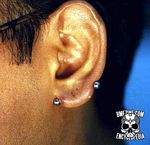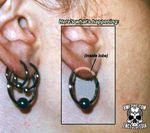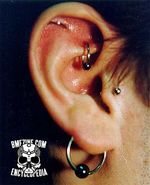Transverse Lobe
Jump to navigation
Jump to search
A transverse lobe is an earlobe piercing turned 90 degrees such that the length of the piercing is parallel to the sagittal plane of the earlobe. Most often, it runs as close to horizontally as the ear will permit.
Contents |
Placement
- A transverse lobe piercing follows the transverse plane, perpendicular to the coronal plane of the earlobe. A horizontal transverse lobe runs from the lateral edge of the lobe to the medial edge. In the case of an attached earlobe, the piercing exits on the inferior edge, rather than the medial edge.
- Some consider the vertical lobe piercing and diagonal lobe piercings to be variations of the transverse lobe.
Procedure
- The transverse lobe piercing is most frequently performed as a freehand piercing, due to the amount and nature of tissue involved. When done from the lateral edge in, a receiving tube is often used. If it can be done from the medial edge out, the receiving tube is usually unnecessary. Some piercers prefer to use a curved needle when piercing attached earlobes.
- Surprisingly, most people experience less pain when getting a transverse lobe piercing than with a standard earlobe piercing. The piercing goes through very few nerves, as the inside of the lobe is mainly fatty tissue.
Healing and Aftercare
- When cared for properly, and proper jewelry is utilized, healing a transverse lobe piercing can be a relatively short and uneventful process. Salt soaks are essential to encourage drainage of the piercing and prevent an abscess from forming. The healing process takes about two to ten months, on average.
Health Issues
- The most common problem with the transverse lobe piercing is the occurrence of an abscess. The length of the piercing contributes to this, as well as pressure from the medial edge of the lobe on the ball of a barbell.
- There is also a risk of migration with this piercing if improper jewelry is used. Jewelry that is too heavy is most often the cause, but using a captive bead ring with an internal diameter that is too small can be just as detrimental, similar to the effects of a Small Nipple Ring.
Jewelry
- A straight barbell is most commonly worn when the earlobe is not attached, though, in many cases, a labret of a proper length (something many shops do not carry on a regular basis) is the best option to alleviate the pressure caused by the earlobe trying to return to its natural position.
- A curved barbell is often used when piercing attached lobes. A captive bead ring or a circular barbell may be worn in most transverse lobe piercings, but a proper diameter must be used, and it will be less comfortable for many people with earlobes that are not attached.
- Transverse lobe piercings can be stretched, but it must be done slowly. The amount of tissue around the piercing is considerably less than with most other piercings.
History and Culture
- The Transverse Lobe piercing was named by Shannon Larratt when posting pictures of said piercing to BME in 1995. Some people feel the name is a misnomer, since vertical and diagonal ear piercings are sometimes considered "transverse" but do not follow the transverse plane of the lobe. The transverse plane is described as "dividing the body or any part of it into upper and lower planes"(1) and "a plane at right angles to both the median and frontal planes ... "(2)
Reference
(1) Parker Anthony, Catherine. Textbook of anatomy and physiology. Saint Louis: The C.V. Mosby Company, 1967.
(2) Gray, Henry. Anatomy of the human body. Philadelphia: Lea & Febiger, 1918.
See Also
Many more pictures and experiences can be found on BME


